With inflation and high grocery prices still frustrating many voters, Vice President Kamala Harris on Friday proposed a ban on “price gouging” by food suppliers and grocery stores, as part of a broader agenda aimed at lowering the cost of housing, medicine, and food.
It’s an attempt to tackle a clear vulnerability of Harris’ head-on: Under the Biden-Harris administration, grocery prices have shot up 21%, part of an inflation surge that has raised overall costs by about 19% and soured many Americans on the economy, even as unemployment fell to historic lows. Wages have also risen sharply since the pandemic, and have outpaced prices for more than a year. Still, surveys find Americans continue to struggle with higher costs.
“We all know that prices went up during the pandemic when the supply chains shut down and failed,” Harris said Friday in Raleigh, North Carolina. “But our supply chains have now improved and prices are still too high.”
Will her proposals do much to lower prices? And what even is “price gouging”? The answers to those and other questions are below:
There is no strict definition that economists would agree on, but it generally refers to spikes in prices that typically follow a disruption in supply, such as after a hurricane or other natural disaster. Consumer advocates charge that gouging occurs when retailers sharply increase prices, particularly for necessities, under such circumstances.
Several states already restrict price gouging, but there is no federal-level ban.
There are federal restrictions on related but different practices, such as price-fixing laws that bar companies from agreeing to not compete against each other and set higher prices.
Most economists would say no, though her plan could have an impact on future crises. For one thing, it’s unclear how much price gouging is going on right now.
Grocery prices are still painfully high compared to four years ago, but they increased just 1.1% in July compared with a year earlier, according to the most recent inflation report. That is in line with pre-pandemic increases.
President Joe Biden said Wednesday that inflation has been defeated after Wednesday’s inflation report showed that it fell to 2.9% in July, the smallest increase in three years.
“There’s some dissonance between claiming victory on the inflation front in one breath and then arguing that there’s all this price gouging happening that is leading consumers to face really high prices in another breath,” said Michael Strain, an economist at the American Enterprise Institute.
In general, after an inflationary spike, it’s very hard to return prices to where they were. Sustained price declines typically only happen in steep, protracted recessions. Instead, economists generally argue that the better approach is for wages to keep rising enough so that Americans can handle the higher costs.
Probably because inflation remains a highly salient issue politically. And plenty of voters do blame grocery stores, fast food chains, and food and packaged goods makers for the surge of inflation in the past three years. Corporate profits soared in 2021 and 2022.
“It could be that they’re looking at opinion polls that show that the number one concern facing voters is inflation and that a large number of voters blame corporations for inflation,” Strain said.
At the same time, even if prices aren’t going up as much, as Harris noted, they remain high, even as supply chain kinks have been resolved.
Elizabeth Pancotti, a policy analyst at Roosevelt Forward, a progressive advocacy group, points to the wood pulp used in diapers. The price of wood pulp has fallen by half from its post-pandemic peak, yet diaper prices haven’t.
“So that just increases the (profit) margins for both the manufacturers and the retailers,” she said.
Most economists would say no, that it was a more straightforward case of supply and demand. When the pandemic hit, meat processing plants were occasionally closed after COVID-19 outbreaks, among other disruptions to supply. Russia’s invasion of Ukraine lifted the cost of wheat and other grains on global markets. Auto prices rose as carmakers were unable to get all the semiconductors they needed from Taiwan to manufacture cars, and many car plants shut down temporarily.
At the same time, several rounds of stimulus checks fattened Americans’ bank accounts, and after hunkering down during the early phase of the pandemic, so-called “revenge spending” took over. The combination of stronger demand and reduced supply was a recipe for rising prices.
Still, some economists have argued that large food and consumer goods companies took advantage of pandemic-era disruptions. Consumers saw empty store shelves and heard numerous stories about disrupted supply chains, and at least temporarily felt they had little choice but to accept the higher prices.








